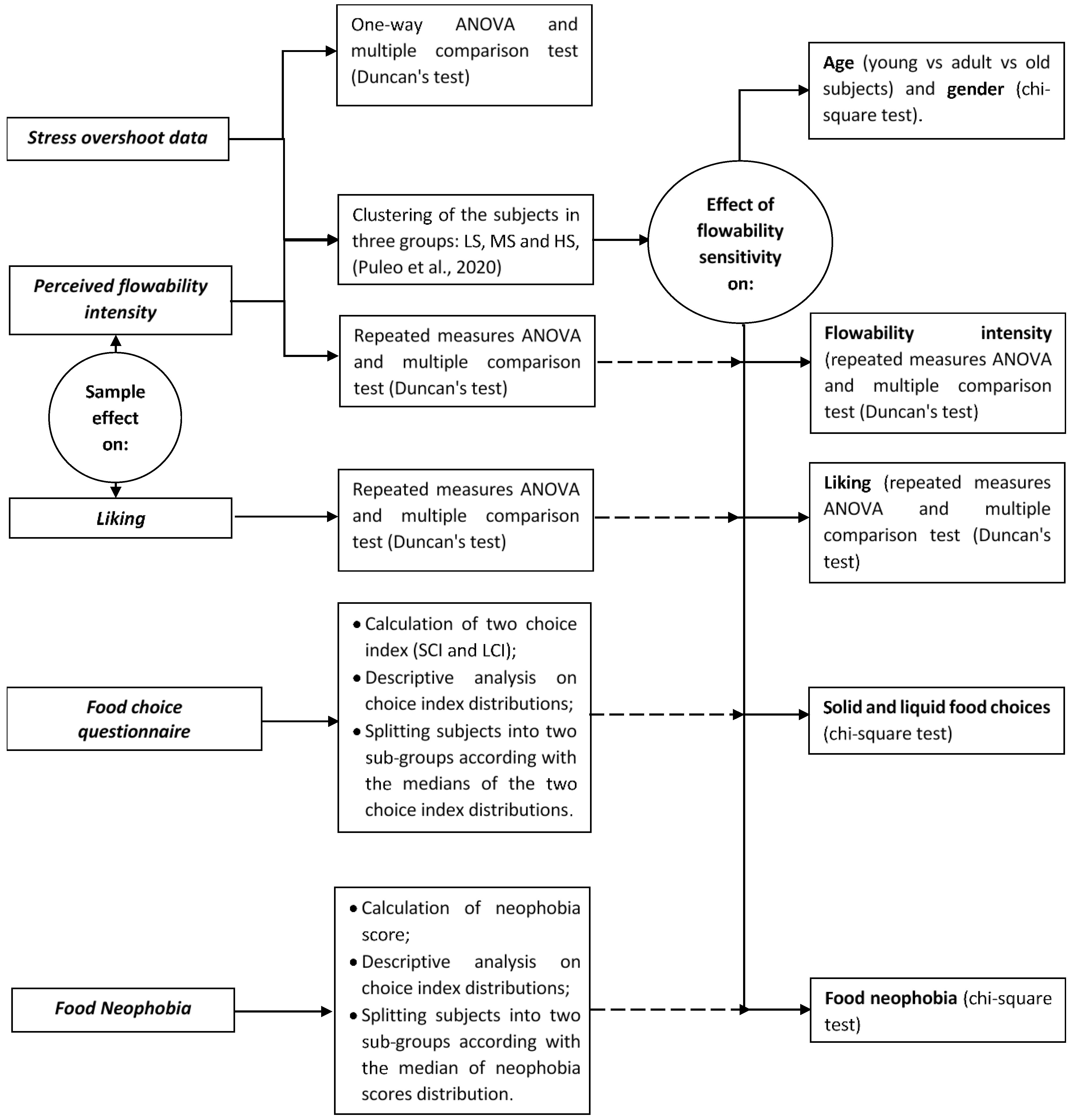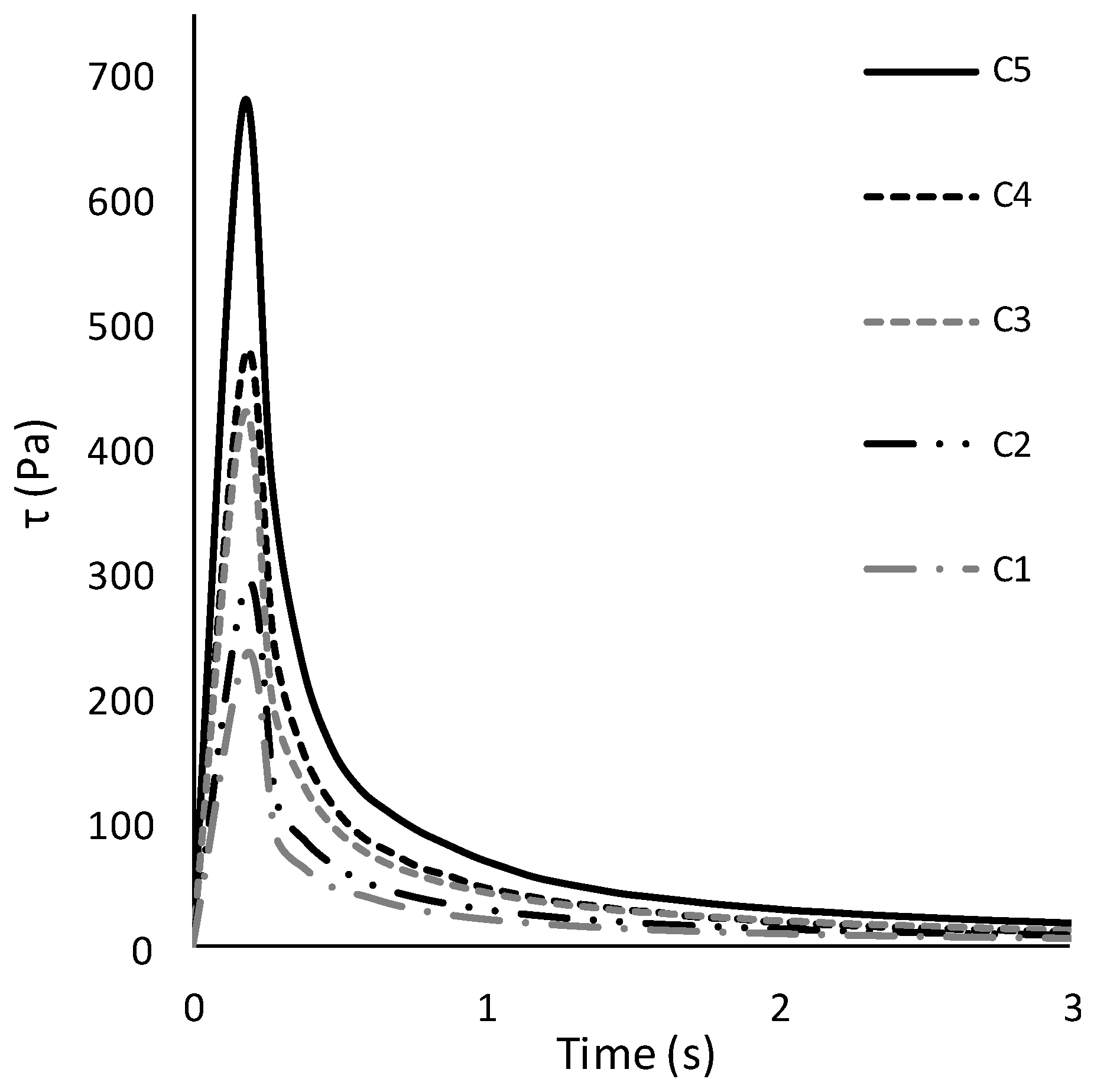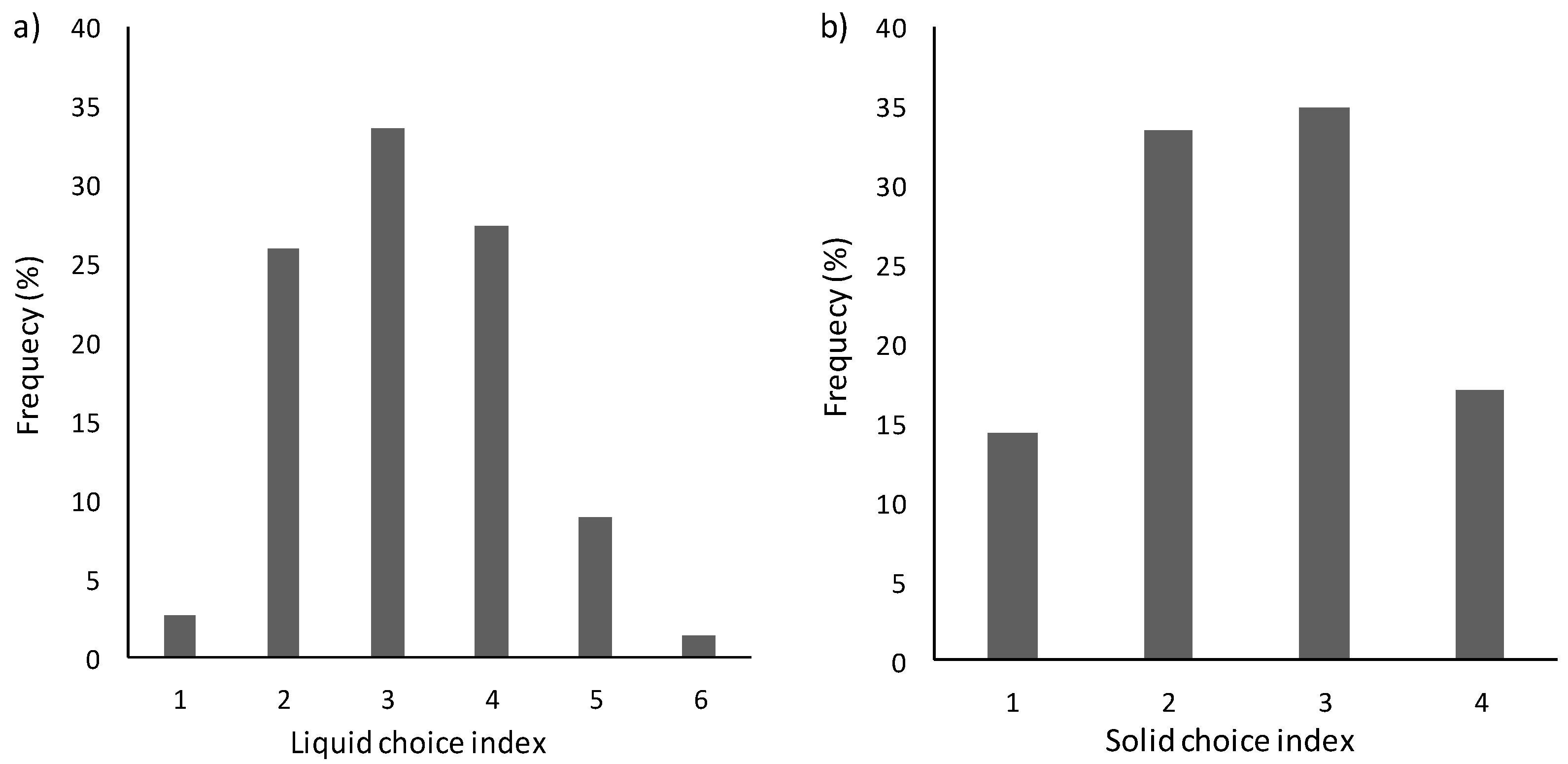Oral Sensitivity to Flowability and Food Neophobia Drive Food Preferences and Choice
Abstract
1. Introduction
2. Materials and Methods
2.1. Sample Preparation
2.2. Rheological Properties: Stress Overshoot
2.3. Consumer Evaluation Overview
2.3.1. Participants
2.3.2. Online Questionnaire
2.3.3. Sensory Evaluation
2.4. Data Analysis
3. Results
3.1. Rheological Properties: Stress Overshoot
3.2. Sensory Evaluation
4. Discussion
4.1. Rheological Properties: Stress Overshoot
4.2. Sensory Evaluation
5. Conclusions
Supplementary Materials
Author Contributions
Funding
Institutional Review Board Statement
Informed Consent Statement
Data Availability Statement
Acknowledgments
Conflicts of Interest
References
- Bourne, M. Food Texture and Viscosity: Concept and Measurement, 2nd ed.; Academic Press: London, UK, 2002; pp. 1–30. [Google Scholar]
- Schiffman, S. Food recognition by the elderly. J. Gerontol. 1977, 32, 586–592. [Google Scholar] [CrossRef] [PubMed]
- Scott, C.L.; Downey, R.G. Types of food aversions: Animal, vegetable, and texture. J. Psychol. 2007, 141, 127–134. [Google Scholar] [CrossRef]
- Birch, L.L. Development of food preferences. Annu. Rev. Nutr. 1999, 19, 41–62. [Google Scholar] [CrossRef]
- Kim, U.K.; Breslin, P.A.S.; Reed, D.; Drayna, D. Genetics of human taste perception. J. Dent. Res. 2004, 83, 448–453. [Google Scholar] [CrossRef] [PubMed]
- Mennella, J.A.; Pepino, M.Y.; Duke, F.F.; Reed, D.R. Psychophysical dissection of genotype effects on human bitter perception. Chem. Senses 2011, 36, 161–167. [Google Scholar] [CrossRef] [PubMed]
- Mennella, J.A.; Pepino, M.Y.; Reed, D.R. Genetic and environmental determinants of bitter perception and sweet preferences. Pediatrics 2005, 115, e216–e222. [Google Scholar] [CrossRef] [PubMed]
- Szczesniak, A.S. Texture is a sensory property. Food Qual. Prefer. 2002, 13, 215–225. [Google Scholar] [CrossRef]
- Baxter, I.A.; Schröder, M.J. Vegetable consumption among Scottish children: A review of the determinants and proposed strategies to overcome low consumption. Br. Food J. 1997, l, 380–387. [Google Scholar] [CrossRef]
- Nu, C.T.; MacLeod, P.; Barthelemy, J. Effects of age and gender on adolescents’ food habits and preferences. Food Qual. Prefer. 1996, 7, 251–262. [Google Scholar] [CrossRef]
- Szczesniak, A.S. Correlating Sensory with Instrumental Texture Measurements—An Overview of Recent Developments. J. Texture Stud. 1987, 18, 1–15. [Google Scholar] [CrossRef]
- Bangcuyo, R.G.; Simons, C.T. Lingual tactile sensitivity: Effect of age group, sex, and fungiform papillae density. Exp. Brain Res. 2017, 235, 2679–2688. [Google Scholar] [CrossRef]
- Etter, N.M.; Miller, O.M.; Ballard, K.J. Clinically available assessment measures for lingual and labial somatosensation in healthy adults: Normative data and test reliability. Am. J. Speech Lang. Pathol. 2017, 26, 982–990. [Google Scholar] [CrossRef] [PubMed]
- Linne, B.; Simons, C.T. Quantification of oral roughness perception and comparison with mechanism of astringency perception. Chem. Senses 2017, 42, 525–535. [Google Scholar] [CrossRef] [PubMed]
- Steele, C.M. The influence of tongue strength on oral viscosity discrimination acuity. J. Texture Stud. 2018, 49, 249–255. [Google Scholar] [CrossRef] [PubMed]
- Steele, C.M.; James, D.F.; Hori, S.; Polacco, R.C.; Yee, C. Oral perceptual discrimination of viscosity differences for non-newtonian liquids in the nectar- and honey-thick ranges. Dysphagia 2014, 29, 355–364. [Google Scholar] [CrossRef] [PubMed]
- Lawless, H.T.; Heymann, H. Sensory Evaluation of Food: Principles and Practice, 2nd ed.; Springer: New York, NY, USA, 2010; p. 127. [Google Scholar]
- Puleo, S.; Miele, N.A.; Cavella, S.; Masi, P.; Di Monaco, R. How sensory sensitivity to graininess could be measured? J. Texture Stud. 2020, 1–10. [Google Scholar] [CrossRef]
- Nederkoorn, C.; Houben, K.; Havermans, R.C. Taste the texture. The relation between subjective tactile sensitivity, mouthfeel and picky eating in young adults. Appetite 2019, 136, 58–61. [Google Scholar] [CrossRef]
- Byrnes, N.K.; Hayes, J.E. Personality factors predict spicy food liking and intake. Food Qual. Prefer. 2013, 28, 213–221. [Google Scholar] [CrossRef] [PubMed]
- Monteleone, E.; Spinelli, S.; Dinnella, C.; Endrizzi, I.; Laureati, M.; Pagliarini, E.; Tesini, F. Exploring influences on food choice in a large population sample: The Italian Taste project. Food Qual. Prefer. 2017, 59, 123–140. [Google Scholar] [CrossRef]
- Spinelli, S.; De Toffoli, A.; Dinnella, C.; Laureati, M.; Pagliarini, E.; Bendini, A.; Braghieri, A.; Toschi, T.G.; Sinesio, F.; Torri, L.; et al. Personality traits and gender influence liking and choice of food pungency. Food Qual. Prefer. 2018, 66, 113–126. [Google Scholar] [CrossRef]
- Törnwall, O.; Silventoinen, K.; Hiekkalinna, T.; Perola, M.; Tuorila, H.; Kaprio, J. Identifying flavor preference subgroups. Genetic basis and related eating behavior traits. Appetite 2014, 75, 1–10. [Google Scholar] [CrossRef] [PubMed]
- Cooke, L. Genetic and environmental influences on food neophobia. In Food Neophobia: Behavioral and Biological Influences; Reilly, S., Ed.; Woodhead Publishing: Sawston, UK, 2018; pp. 237–254. [Google Scholar]
- Knaapila, A.; Tuorila, H.; Silventoinen, K.; Keskitalo, K.; Kallela, M.; Wessman, M.; Perola, M. Food neophobia shows heritable variation in humans. Physiol. Behav. 2007, 91, 573–578. [Google Scholar] [CrossRef] [PubMed]
- Torri, L.; Tuccillo, F.; Bonelli, S.; Piraino, S.; Leone, A. The attitudes of Italian consumers towards jellyfish as novel food. Food Qual. Prefer. 2020, 79, 103782. [Google Scholar] [CrossRef]
- Tan, H.S.G.; Fischer, A.R.H.; van Trijp, H.C.M.; Stieger, M. Tasty but nasty? Exploring the role of sensory-liking and food appropriateness in the willingness to eat unusual novel foods like insects. Food Qual. Prefer. 2016, 48, 293–302. [Google Scholar] [CrossRef]
- Kutbi, H.A.; Alhatmi, A.A.; Alsulami, M.H.; Alghamdi, S.S.; Albagar, S.M.; Mumena, W.A.; Mosli, R.H. Food neophobia and pickiness among children and associations with socioenvironmental and cognitive factors. Appetite 2019, 142, 104373. [Google Scholar] [CrossRef] [PubMed]
- Dovey, T.M.; Staples, P.A.; Gibson, E.L.; Halford, J.C.G. Food neophobia and “picky/fussy” eating in children: A review. Appetite 2008, 50, 181–193. [Google Scholar] [CrossRef]
- Coulthard, H.; Blissett, J. Fruit and vegetable consumption in children and their mothers. Moderating effects of child sensory sensitivity. Appetite 2009, 52, 410–415. [Google Scholar] [CrossRef] [PubMed]
- Coulthard, H.; Sahota, S. Food neophobia and enjoyment of tactile play: Associations between preschool children and their parents. Appetite 2016, 97, 155–159. [Google Scholar] [CrossRef] [PubMed]
- Puleo, S.; Valentino, M.; Masi, P.; Di Monaco, R. Hardness sensitivity: Are old, young, female and male subjects all equally sensitive? Food Qual. Prefer. 2020, 90, 104–118. [Google Scholar] [CrossRef]
- Engelen, L.; van den Keybus, P.A.M.; de Wijk, R.A.; Veerman, E.C.I.; Amerongen, A.V.N.; Bosman, F.; Prinz, J.F.; van der Bilt, A. The effect of saliva composition on texture perception of semi-solids. Arch. Oral Biol. 2007, 52, 518–525. [Google Scholar] [CrossRef] [PubMed]
- Smith, C.H.; Logemann, J.A.; Burghardt, W.R.; Zecker, S.G.; Rademaker, A.W. Oral and oropharyngeal perceptions of fluid viscosity across the age span. Dysphagia 2006, 21, 209–217. [Google Scholar] [CrossRef] [PubMed]
- Dickie, A.M.; Kokini, J.L. An Improved Model for Food Thickness from non-Newtonian Fluid Mechanics in the Mouth. J. Food Sci. 1983, 48, 57–61. [Google Scholar] [CrossRef]
- Prentice, J.H. Dairy Rheology: A Concise Guide; VCH Publishers, Inc.: New York, NY, USA, 1992. [Google Scholar]
- Pliner, P.; Hobden, K. Development of a scale to measure the trait of food neophobia in humans. Appetite 1992, 19, 105–120. [Google Scholar] [CrossRef]
- Lukasewycz, L.D.; Mennella, J.A. Lingual tactile acuity and food texture preferences among children and their mothers. Food Qual. Prefer. 2012, 26, 58–66. [Google Scholar] [CrossRef] [PubMed]
- Schutz, H.G.; Cardell, A.V. A labeled affective magnitude (LAM) scale for assessing food liking/disliking. J. Sens. Stud. 2001, 16, 117–159. [Google Scholar] [CrossRef]
- Bartoshuk, L.M.; Duffy, V.B.; Green, B.G.; Hoffman, H.J.; Ko, C.W.; Lucchina, L.A.; Weiffenbach, J.M. Valid across-group comparisons with labeled scales: The gLMS versus magnitude matching. Physiol. Behav. 2004, 82, 109–114. [Google Scholar] [CrossRef]
- Aktar, T.; Chen, J.; Ettelaie, R.; Holmes, M. Evaluation of the sensory correlation between touch sensitivity and the capacity to discriminate viscosity. J. Sens. Stud. 2015, 30, 98–107. [Google Scholar] [CrossRef]
- Laureati, M.; Spinelli, S.; Monteleone, E.; Dinnella, C.; Prescott, J.; Cattaneo, C.; Pagliarini, E. Associations between food neophobia and responsiveness to “warning” chemosensory sensations in food products in a large population sample. Food Qual. Prefer. 2018, 68, 113–124. [Google Scholar] [CrossRef]
- da Silva, T.L.T.; Arellano, D.B.; Martini, S. Effect of Water Addition on Physical Properties of Emulsion Gels. Food Biophys. 2019, 14, 30–40. [Google Scholar] [CrossRef]
- Elliot, J.H.; Ganz, A.J. Salad Dressings-Preliminary rheological characterization. J. Texture Stud. 1978, 8, 359–371. [Google Scholar] [CrossRef]
- Lee, J.; Song, K. Rheological Characterization of Carbopol 940 in Steady Shear and Start-up Flow Fields. In Annual Transactions; The Nordic Rheology Society: Trondheim, Norway, 2011; Volume 19. [Google Scholar]
- Ahuja, A.; Lu, J.; Potanin, A. Rheological predictions of sensory attributes of lotions. J. Texture Stud. 2019, 50, 295–305. [Google Scholar] [CrossRef] [PubMed]
- Karyappa, R.; Hashimoto, M. Chocolate-based Ink Three-dimensional Printing (Ci3DP). Sci. Rep. 2019, 9, 1–11. [Google Scholar] [CrossRef]
- Richardson, R.K.; Morris, E.R.; Ross, M.S.B.; Taylor, J.L.; Dea, I.C.M. Characterization of the perceived texture of thickened systems by dynamic viscosity measurements. Food Hydrocoll. 1989, 3, 175–191. [Google Scholar] [CrossRef]
- Pangborn, R.M.; Gibbs, Z.M.; Tassan, C. Effect of Hydrocolloids on Apparent Viscosity and Sensory Properties of Selected Beverages. J. Texture Stud. 1978, 9, 415–436. [Google Scholar] [CrossRef]
- Baron, R.; Penfield, M.P. Panelist Texture Preferences Affect Sensory Evaluation of Green Bean Cultivars Phaseohs vulgaris L. J. Food Sci. 1993, 58, 138–139. [Google Scholar] [CrossRef]
- Michon, C.; O’Sullivan, M.G.; Sheehan, E.; Delahunty, C.M.; Kerry, J.P. Study on the influence of age, gender and familiarity with the product on the acceptance of vegetable soups. Food Qual. Prefer. 2010, 21, 478–488. [Google Scholar] [CrossRef]
- Monteleone, E.; Frewer, L.; Wakeling, I.; Mela, D.J. Individual differences in starchy food consumption: The application of preference mapping. Food Qual. Prefer. 1998, 9, 211–219. [Google Scholar] [CrossRef]
- Pliner, P. The Effects of Mere Exposure on Liking for Edible Substances. Appetite 1982, 3, 283–290. [Google Scholar] [CrossRef]
- Richardson-Harman, N.J.; Stevens, R.; Walker, S.; Gamble, J.; Miller, M.; Wong, M.; McPherson, A. Mapping consumer perceptions of creaminess and liking for liquid dairy products. Food Qual. Prefer. 2000, 11, 239–246. [Google Scholar] [CrossRef]
- Kälviäinen, N.; Roininen, K.; Tuorila, H. Sensory characterization of texture and flavor of high viscosity gels made with different thickeners. J. Texture Stud. 2000, 31, 407–420. [Google Scholar] [CrossRef]
- Nielsen, N.A.; Bech-Larsen, T.; Grunert, K.G. Consumer purchase motives and product perceptions: A laddering study on vegetable oil in three countries. Food Qual. Prefer. 1998, 9, 455–466. [Google Scholar] [CrossRef]
- Kim, Y.K.; Jombart, L.; Valentin, D.; Kim, K.O. A cross-cultural study using Napping®: Do Korean and French consumers perceive various green tea products differently? Food Res. Int. 2013, 53, 534–542. [Google Scholar] [CrossRef]
- Kim, Y.K.; Valentin, D.; Kim, K.O. Familiarity and liking playing a role on the perception of trained panelists: A cross-cultural study on teas. Food Res. Int. 2015, 71, 155–164. [Google Scholar] [CrossRef]
- Kremer, S.; Bult, J.H.F.; Mojet, J.; Kroeze, J.H.A. Food perception with age and its relationship to pleasantness. Chem. Senses 2007, 32, 591–602. [Google Scholar] [CrossRef]
- Kremer, S.; Mojet, J.; Kroeze, J.H.A. Perception of texture and flavor in soups by elderly and young subjects. J. Texture Stud. 2005, 36, 255–272. [Google Scholar] [CrossRef]
- Kim, S.; Vickers, Z. Liking of food textures and its relationship with oral physiological parameters and mouth-behavior groups. J. Texture Stud. 2019. [Google Scholar] [CrossRef] [PubMed]
- Pliner, P.; Salvy, S.J. Food neophobia in humans. In The Psychology of Food Choice; Shepherd, R., Raats, M., Eds.; CABI Publishing: Wallingford, UK, 2006; pp. 75–92. [Google Scholar]
- Tuorila, H.; Lähteenmäki, L.; Pohjalainen, L.; Lotti, L. Food neophobia among the Finns and related responses to familiar and unfamiliar foods. Food Qual. Prefer. 2001, 12, 29–37. [Google Scholar] [CrossRef]
- Jaeger, S.R.; Rasmussen, M.A.; Prescott, J. Relationships between food neophobia and food intake and preferences: Findings from a sample of New Zealand adults. Appetite 2017, 116, 410–422. [Google Scholar] [CrossRef]




| Liquid Texture Domain | Thin Option | Thick Option |
| Milk | Yoghurt | |
| Coffee | Cream of coffee | |
| Fruit juice | Fruit centrifuge | |
| Fruit smoothie | Fruit frappé | |
| Vegetable broth | Vegetable creamed soup | |
| Solid Texture Domain | Soft Option | Hard Option |
| Italian ice cream | Ice lolly | |
| Sandwich bread | Crackers | |
| Soft chocolate snack | Chocolate bar | |
| Plum cake | Cookies |
| Sample Code | Solid Concentration (% w/v) | Food Liking (LAM Scale) | Perceived Flowability (gLM Scale) |
|---|---|---|---|
| C1 | 31 | 60 ± 1 a | 22 ± 1 a |
| C2 | 33 | 60.5 ± 0.9 ab | 21 ± 1 a |
| C3 | 36 | 63.5 ± 0.9 c | 28 ± 1 b |
| C4 | 39 | 63.1 ± 0.9 bc | 40 ± 1 c |
| C5 | 43 | 62.6 ± 0.9 abc | 37 ± 2 c |
| Quartiles | Angular Coefficient | R2 |
|---|---|---|
| 1st Quartile | 113.0 | 0.40 |
| Median | 176.4 | 0.67 |
| 3rd Quartile | 294.8 | 0.89 |
| Maximum | 776.0 | 0.99 |
| Minimum | 1.99 | 0.001 |
| Perceived Flowability (gLM Scale) | ||||||
| Groups | C1 31% w/v | C2 33% w/v | C3 36% w/v | C4 39% w/v | C5 43% w/v | Significance Within Groups |
| LS (n = 48) | 29 ± 2 bA | 26 ± 2 bA | 29 ± 2 aA | 28 ± 3 aA | 23 ± 3 aA | 0.12 n.s. |
| MS (n = 83) | 20 ± 2 aA | 19 ± 2 aA | 28 ± 2 aB | 36 ± 3 bC | 40 ± 2 bC | <0.0001 |
| HS (n = 45) | 17. ± 3 aA | 18 ± 2 aA | 25 ± 2 aB | 36 ± 2 abC | 45 ± 3 bC | <0.0001 |
| Significance between groups | 0.003 | 0.01 | 0.5n.s. | 0.03 | 0.0001 | - |
| Food Liking (LAM scale) | ||||||
| Groups | C1 31% w/v | C2 33% w/v | C3 36% w/v | C4 39% w/v | C5 43% w/v | Significance Within Groups |
| LS (n = 48) | 60 ± 2 aA | 62 ± 2 aA | 61 ± 2 aA | 63 ± 2 aA | 60 ± 2 aA | 0.4 n.s. |
| MS (n = 83) | 61 ± 2 aAB | 60 ± 1 aA | 63 ± 1 abAB | 62 ± 1 aAB | 65 ± 1 aB | 0.02 |
| HS (n = 45) | 59 ± 2 aA | 60 ± 2 aA | 67 ± 2 bC | 66 ± 2 aBC | 62 ± 2 aAB | 0.003 |
| Significance between groups | 0.89 n.s. | 0.62 n.s. | 0.04 | 0.24 n.s. | 0.10 n.s. | - |
Publisher’s Note: MDPI stays neutral with regard to jurisdictional claims in published maps and institutional affiliations. |
© 2021 by the authors. Licensee MDPI, Basel, Switzerland. This article is an open access article distributed under the terms and conditions of the Creative Commons Attribution (CC BY) license (https://creativecommons.org/licenses/by/4.0/).
Share and Cite
Puleo, S.; Masi, P.; Cavella, S.; Di Monaco, R. Oral Sensitivity to Flowability and Food Neophobia Drive Food Preferences and Choice. Foods 2021, 10, 1024. https://doi.org/10.3390/foods10051024
Puleo S, Masi P, Cavella S, Di Monaco R. Oral Sensitivity to Flowability and Food Neophobia Drive Food Preferences and Choice. Foods. 2021; 10(5):1024. https://doi.org/10.3390/foods10051024
Chicago/Turabian StylePuleo, Sharon, Paolo Masi, Silvana Cavella, and Rossella Di Monaco. 2021. "Oral Sensitivity to Flowability and Food Neophobia Drive Food Preferences and Choice" Foods 10, no. 5: 1024. https://doi.org/10.3390/foods10051024
APA StylePuleo, S., Masi, P., Cavella, S., & Di Monaco, R. (2021). Oral Sensitivity to Flowability and Food Neophobia Drive Food Preferences and Choice. Foods, 10(5), 1024. https://doi.org/10.3390/foods10051024







